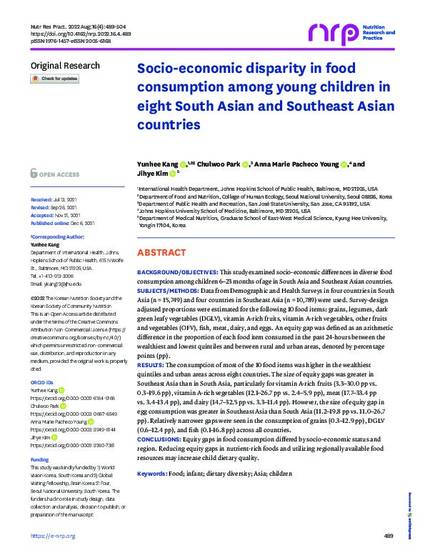
BACKGROUND/OBJECTIVES
This study examined socio-economic differences in diverse food consumption among children 6–23 months of age in South Asia and Southeast Asian countries.
SUBJECTS/METHODS
Data from Demographic and Health Surveys in four countries in South Asia (n = 15,749) and four countries in Southeast Asia (n = 10,789) were used. Survey-design adjusted proportions were estimated for the following 10 food items: grains, legumes, dark green leafy vegetables (DGLV), vitamin A-rich fruits, vitamin A-rich vegetables, other fruits and vegetables (OFV), fish, meat, dairy, and eggs. An equity gap was defined as an arithmetic difference in the proportion of each food item consumed in the past 24-hours between the wealthiest and lowest quintiles and between rural and urban areas, denoted by percentage points (pp).
RESULTS
The consumption of most of the 10 food items was higher in the wealthiest quintiles and urban areas across eight countries. The size of equity gaps was greater in Southeast Asia than in South Asia, particularly for vitamin A-rich fruits (3.3–30.0 pp vs. 0.3–19.6 pp), vitamin A-rich vegetables (12.1–26.7 pp vs. 2.4–5.9 pp), meat (17.7–33.4 pp vs. 3.4–13.4 pp), and dairy (14.7–32.5 pp vs. 3.3–11.4 pp). However, the size of equity gap in egg consumption was greater in Southeast Asia than South Asia (11.2–19.8 pp vs. 11.0–26.7 pp). Relatively narrower gaps were seen in the consumption of grains (0.3–12.9 pp), DGLV (0.6–12.4 pp), and fish (0.1–16.8 pp) across all countries.
CONCLUSIONS Equity gaps in food consumption differed by socio-economic status and region. Reducing equity gaps in nutrient-rich foods and utilizing regionally available food resources may increase child dietary quality.
- Food,
- infant,
- dietary diversity,
- Asia,
- children
Available at: http://works.bepress.com/chulwoo-charles-park/33/

This is the Version of Record and can also be read online href="https://doi.org/10.4162/nrp.2022.16.4.489">here.